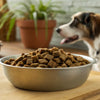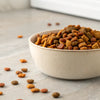Enhancing Your Dog's Diet: What Can I Add to Dry Dog Food?
- Houndsy
Table of Contents
- Introduction
- Understanding the Need for Enhancements
- Healthy Additions to Dry Dog Food
- Balancing Your Dog's Diet with Houndsy
- Example Feeding Routine
- Conclusion
Introduction
Did you know that more than 60% of dog owners choose dry dog food as their pet's primary diet? While kibble is convenient and affordable, it often lacks the freshness and nutritional diversity that our furry friends truly deserve. As pet parents, we want to ensure that our dogs receive the best possible nutrition, which makes the question, “What can I add to dry dog food?” incredibly relevant.
In this blog post, we will explore various nutritious and appetizing options that can elevate your dog’s dry food experience. By the end of this article, you will understand the importance of enhancing dry dog food, the best ingredients to mix in, and how these additions can improve your pet’s overall health and happiness. We will also reflect on our own feeding routines and consider how simple changes can lead to a more enriching dining experience for our dogs.
So, let’s dive into the world of dog food enhancements and discover how we can transform mealtime into something exciting and nutritious!
Understanding the Need for Enhancements
Why Dry Dog Food Alone Isn’t Enough
While dry dog food provides essential nutrients, it often lacks variety and freshness. Dogs thrive on a balanced diet that includes a mix of proteins, fats, vitamins, and minerals. However, many dry foods are high in carbohydrates and low in moisture, which can lead to health issues over time. A primary concern is that highly processed kibble can be less appealing to dogs, leading to picky eating habits, and may not provide the full spectrum of nutrients they need.
Benefits of Adding Fresh Ingredients
- Nutritional Boost: Fresh ingredients can enhance the nutritional profile of dry dog food, providing vitamins, minerals, and healthy fats.
- Improved Palatability: Adding various foods can make kibble more appetizing, encouraging dogs to eat their meals consistently.
- Hydration: Many fresh foods contain higher moisture content, which can help keep dogs hydrated—an essential aspect of their health.
- Variety: Just like us, dogs enjoy variety in their meals. Adding different foods can make mealtime more exciting and enjoyable.
Guidelines for Enhancing Dry Dog Food
When considering what to add to dry dog food, remember that these enhancements should make up only a small portion of your dog’s overall caloric intake—ideally no more than 10-25%. Monitoring your dog’s response to new foods and consulting with a veterinarian for personalized advice is essential.
Healthy Additions to Dry Dog Food
Now that we understand the importance of enhancing dry dog food, let’s explore some nutritious options we can incorporate into our dogs’ meals.
1. Proteins
Eggs
Eggs are a powerhouse of nutrients, rich in protein and essential fatty acids. They can be served raw, soft-boiled, or scrambled. For medium to large dogs, one egg a day is generally safe, while smaller breeds may only require half an egg.
Lean Meats
Cooked chicken, turkey, or lean beef can add protein and flavor to your dog’s diet. Always ensure the meat is boneless and free from seasoning. For added variety, consider organ meats like liver or heart, but do so in moderation.
Fish
Canned fish, such as sardines or salmon, packed in water, is an excellent source of Omega-3 fatty acids, which are beneficial for skin and coat health. Limit fish to a few times a week to avoid excessive mercury exposure.
2. Dairy Products
Many dogs enjoy dairy, but it’s crucial to choose low-lactose options.
Greek Yogurt
Plain Greek yogurt is rich in probiotics and can aid digestion. A spoonful mixed into dry food can add creaminess and flavor.
Cottage Cheese
Low-fat cottage cheese is another option that provides protein and calcium. However, moderation is key due to its lactose content.
3. Fruits and Vegetables
Cooked or Pureed Vegetables
Dogs can benefit from various vegetables, such as carrots, green beans, and peas. Cooking or pureeing these veggies makes them easier to digest. Limit the amount to about ¼ cup per 10 pounds of body weight.
Fruits
Many fruits are safe and nutritious for dogs, such as apples (without seeds), blueberries, and bananas. These can provide antioxidants and essential vitamins, but should be given in moderation due to their sugar content.
Canned Pumpkin
Canned pumpkin (not pie filling) is an excellent source of fiber, helping with digestion and promoting gut health. A small spoonful can improve your dog’s kibble experience while also aiding digestion.
4. Healthy Fats
Fish Oil
Adding fish oil to your dog’s diet can improve coat health and provide important Omega-3 fatty acids. Ensure you choose high-quality, pet-safe fish oil.
Coconut Oil
This healthy fat can also be beneficial, providing energy and supporting skin health. Introduce it gradually to avoid digestive upset.
Balancing Your Dog's Diet with Houndsy
At Houndsy, our mission is to simplify and elevate the dog-feeding experience. Our flagship product, the Houndsy Kibble Dispenser, supports your efforts to enhance your dog's diet by offering perfect portion control and ergonomic convenience. With features like a large storage capacity and a beautiful mid-century modern design, our dispenser makes it easy to integrate fresh ingredients into your dog’s meals without the mess.
The Importance of Quality and Reliability
When considering what to add to dry dog food, it’s vital to focus on quality. High-quality, fresh ingredients will provide the best nutritional benefits. Always ensure that the foods you are adding are safe for dogs, avoiding harmful ingredients like grapes, onions, or excessive salt.
Example Feeding Routine
To illustrate how we can boost our dogs' nutrition, here’s a hypothetical example of a feeding routine:
Morning Meal: 2 cups of dry kibble mixed with one egg (scrambled) and a spoonful of plain Greek yogurt. This provides a great start to the day with protein and probiotics.
Evening Meal: 2 cups of dry kibble topped with ½ cup of cooked green beans and a small scoop of canned pumpkin. This adds fiber and nutrients, making the meal more satisfying.
Conclusion
Enhancing your dog's dry food can transform mealtime into a more enjoyable and nutritious experience. By adding proteins, healthy fats, fruits, and vegetables, we can address the shortcomings of kibble and provide our furry friends with a well-rounded diet.
As we reflect on our feeding routines, let’s remember that small changes can lead to significant improvements in our pets’ health and happiness. If you’re ready to take the next step in elevating your dog’s feeding experience, consider exploring the Houndsy Kibble Dispenser for an innovative and stylish solution.
FAQ
What can I add to dry dog food to make it more appealing?
You can add proteins like cooked lean meats, eggs, or fish, along with fresh fruits and vegetables, yogurt, or canned pumpkin to enhance the flavor and nutrition of dry dog food.
How much should I add to my dog's food?
Generally, enhancements should make up about 10-25% of your dog's daily caloric intake to maintain a balanced diet.
Are there any foods I should avoid adding?
Yes, avoid adding toxic foods such as grapes, raisins, onions, garlic, and excessive salt.
Can I mix wet food with dry kibble?
Absolutely! Mixing wet food can increase moisture and palatability, making it a great option for picky eaters.
How can I ensure my dog is getting a balanced diet?
Consult with your veterinarian to determine the best enhancements for your dog's specific dietary needs and monitor their health regularly.












